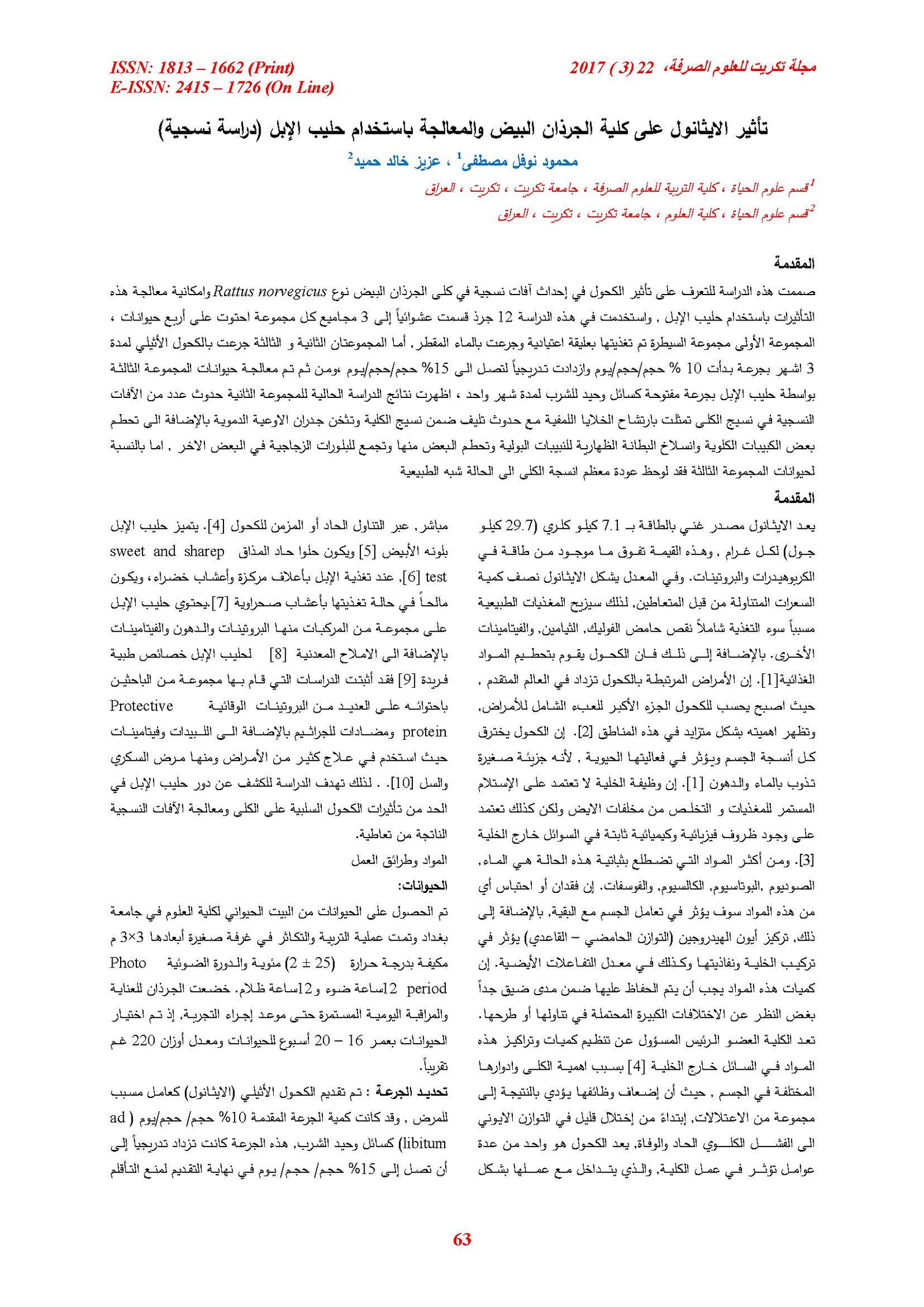effect of Ethanol on the kidney of the white rat Rattus norvegicus followed by treatment with camel milk (histological study)
Main Article Content
Abstract
This study was designed to identify the influence of alcohol in the inducing histological lesions in the kidney of white rats and the possibility of treating these effects by using camel milk. In this study ,12 rats were used and randomly divided into three groups each group contained four animals, the first group was control group had been fed by usual diet and administrated by distilled water, second and third groups administrated by ethanol for 3 months (a dose began at 10% v / v / day and gradually increase to up to 15% v / v / day), then Group C were treated by camel milk with open dose for one month , the results of the current study, showed that the second group occurrence of a number of histopathological lesions in the kidney tissue represented by infiltration of lymphocytes with the occurrence of fibrosis within the overall tissues and thickening walls of the blood vessels in addition to the destroyed of some glomeruli and desquamation of the lining epithelial of proximal and distal tubules and destroyed of others , and accumulation of hyaline crystals in lumen of others, As for the third group it had been observed most of the kidney tissues returned to a semi-natural state.
Article Details

This work is licensed under a Creative Commons Attribution 4.0 International License.
Tikrit Journal of Pure Science is licensed under the Creative Commons Attribution 4.0 International License, which allows users to copy, create extracts, abstracts, and new works from the article, alter and revise the article, and make commercial use of the article (including reuse and/or resale of the article by commercial entities), provided the user gives appropriate credit (with a link to the formal publication through the relevant DOI), provides a link to the license, indicates if changes were made, and the licensor is not represented as endorsing the use made of the work. The authors hold the copyright for their published work on the Tikrit J. Pure Sci. website, while Tikrit J. Pure Sci. is responsible for appreciate citation of their work, which is released under CC-BY-4.0, enabling the unrestricted use, distribution, and reproduction of an article in any medium, provided that the original work is properly cited.
References
1- Lieber CS. Medical and nutritional complications of alcoholism: mechanisms and management. New York: Plenum, 1992:579.
2- Ezzati M, Lopez A, Rodgers A, Vander Hoorn S, Murray C; the Comparative Risk Assessment Collaborating Group. Selected major risk factors and global and regional burden of disease. Lancet 2002;360:1347- 1360
3- Beard, J.D.; Barlow, G.; and Overman, R.R. Body fluids and blood electrolytes in dogs subjected to chronic ethanol administration. Journal of Pharmacology and Experimental Therapeutics 148(3):348–355, 1995.
4- Epstein, M. Renal sodium handling in liver disease In: Epstein, M., ed. The Kidney in Liver Disease. 4th ed. Philadelphia: Hanley & Belfus, 1996. pp. 1–31.
6- Elnahas, A.(2008). Ultrasonographical examination of one humped Camels (Camelus dromedaries) liver withsome haematological and biochemical aspects. Ph. D. Thesis. Sudan University.
7- Farah, Z. Rettenmaier, R. and Atkins, D. (2000). Vitamin content of Camel milk. J. Vit. Nutr. Res. 62: 30-33.
8- Shamsia, S.M. (2009). Nutritional and therapeutic properties of Camel and human milks. Inter. J. Gentic and Moleculer Biology. 1(2) pp: 52-58.
9- Yagil, R. (2000). Lactation in the desert Camel
(Camelus romedarius) In: Gahlot, T. K. (ed) selected Topics on Camel ids. The camel Publishers, Bikaner. India. pp: 61-72.
10- Konuspayeva, G.; Loiseau, G. and Faye, B. (2004). A better know led of Milk quality parameters: A preliminary step for improving the
Camel milk market opportunity in a transition economythe case of Kazakhstan. Intl. Conf. 25-28.
11- Laube, H.; Norris, H.T.; and Robbins, S.L. The nephromegaly of chronic alcoholics with liver disease Archives of Pathology 84:290–294, 2006.
14- Hassan, S.M. Saeed, A.K. Hussein, A.J. (2015). Ethanol-induced Hepatic and Renal Histopathological Changes in BALB/c mice. J. nat. sci. res. vol. 5, No.10
15- Omoto, M., Imai, T., Seki, K., Nomura, R. & Nomoto, K. 1997. Effects of long-term ethanol administration on kidney studied at several periods of time during the administration. Nihon Arukoru Yakubutsu Igakkai Zasshi, 32, 27-45.
16- AL-Hashem, F. (2009). Camel's milk protects against Aluminum Chlorid induced toxicity in the liver and kidney of White Albino Rats .Ameri. J. Bioch. Biotech.5(3): 98-109.
17- Martin, H. ; Richert. L and Berthelot, A. (2003). Magnesium deficiency induces apoptosis in primary cultures of rat hepatocytes. Am. Soc.Nut. 133:2505-2511.
18- Barbagallo, M. (1999). Effect of vitamin E and glutathione on glucose metabolism. Hypertension. 34: 1002-1006.
